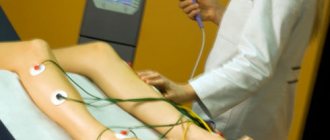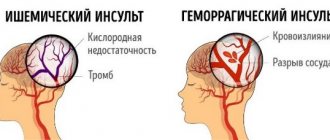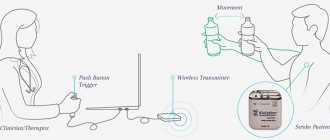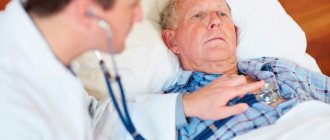A stroke requires a lot of courage from the patient and a lot of patience and love from his loved ones. Because a stroke, or acute cerebrovascular accident, is the most dangerous disease of the cerebral vessels. It is characterized by the occurrence of motor, behavioral, mental, emotional and other disorders that disrupt the patient’s normal functioning.
A stroke is not a one-time event, but a process that develops in time and space - from minor functional changes to irreversible structural damage to the brain - necrosis.
What is insidious about a stroke? The fact that in the first stages of its development a person may not experience any pain. The arm and cheek become numb, speech changes slightly, and sometimes dizziness or blurred vision appears. Neither the patient himself nor his relatives suspect that a brain catastrophe is occurring. Precious time is missed: those six hours from the onset of the disease when adequate therapy can reduce the size of brain damage.
How does a stroke occur? A stroke is an acute disorder of cerebral circulation, that is, a rupture, spasm or blockage of one of the brain vessels. Stroke is divided into hemorrhagic (cerebral hemorrhage) and ischemic (cerebral infarction).
How is stroke treated with leeches?
Hirudotherapy is an auxiliary treatment measure that prevents recurrent stroke. It is also effective in preventing disease. The essence of the treatment is that hirudin resolves blood clots and ensures vascular patency.
For the session, leeches are selected that are grown in factories and kept on a starvation diet for six months. Each worm is used only once, after which it is disposed of. The leech lands on a prepared area of the body and bites the skin at the nearest acupuncture point. Together with her saliva, more than a hundred biologically active substances enter the bloodstream, which have a beneficial effect on health.
Hemorrhagic stroke
The most severe variant of the disease is hemorrhagic stroke.
It is a complication of hypertension. The blood vessel, unable to withstand the increased pressure on the wall, ruptures, and blood enters the brain matter. The resulting hemorrhage compresses the brain, causes swelling, and the area of the brain dies. This type of stroke occurs more often after a difficult, stressful day. By evening my head is splitting with pain. Objects begin to appear red, nausea and vomiting appear, and the headache gets worse - these are the harbingers of a stroke. Then movements, speech, and sensitivity are disrupted, and conditions ranging from mild stupor to loss of consciousness and coma arise—this is the stroke itself.
Treatment of stroke with leeches: prices
Prices for leech treatment depend on the number of leeches used and the number of procedures performed. The cost of the course will be determined by the hirudotherapist after he has drawn up a program taking into account the individual characteristics of the patient’s body.
Hirudotherapy in the treatment of stroke placement of 3 leeches – 1500 rubles
Hirudotherapy in the treatment of stroke, placement of 5 leeches – 2500 rubles
Hirudotherapy in the treatment of stroke placement of 3 leeches – 1500 rubles
Hirudotherapy in the treatment of stroke placement of 5 leeches – 2500 rubles
Hirudotherapy procedure for stroke, placement of 3 leeches – 1500 rubles
Hirudotherapy procedure for stroke, placement of 5 leeches – 2500 rubles
Hirudotherapy in the treatment of ischemic stroke placement of 3 leeches – 1500 rubles
Hirudotherapy in the treatment of ischemic stroke placement of 5 leeches – 2500 rubles
Rehabilitation after stroke
After being hospitalized for a stroke, many patients are left with problems with physical, speech, and mental function. However, in many cases the brain has great potential for recovery.
The rehabilitation process plays a critical role in helping patients regain lost skills so that the patient can regain independence and maintain quality of life. With active, timely, painstaking daily work, these prospects for improving the condition can become even better. Rehabilitation can continue for years after a stroke, but for many patients it occurs most quickly in the first year after the stroke.
This is why it is important for medical specialists - neurologists, physiotherapists, speech therapists and others - to begin working with the victim as soon as possible after a stroke.
A multifunctional medical center is able to offer not only the help of highly qualified specialists, but also has a modern diagnostic base for monitoring the patient’s condition during rehabilitation after a stroke in Moscow, as well as assessing the risks of developing a recurrent stroke, since the proportion of recurrent strokes is high and leads to increased disability or death outcome.
Consequences of a stroke
People come to the clinic for rehabilitation of the consequences of both ischemic and hemorrhagic types of stroke. Depending on which area of the brain is damaged, a stroke can cause the following types of dysfunction:
- Paralysis, paresis
- Pain or loss of sensation
- Problems with speech recognition and articulation
- Cognitive disorders (thinking, memory)
- Emotional disorders
- exacerbation of diseases of the cardiovascular, respiratory, excretory systems, etc.
- Bedsores and their complications in the absence of proper care for a bedridden patient
- swallowing disorders (dysphagia), etc.
Recovery stages
Conventionally, the rehabilitation period after a stroke is divided into several stages:
During the acute period
the main task is to maintain the basic functions of the body and preserve the life of the patient in the hospital.
Early recovery period
in the first six months after a stroke, it is especially important to restore the patient’s motor skills and cognitive abilities - passive gymnastics, massage, breathing exercises and speech restoration classes.
Late recovery period
from six months to a year is characterized by daily supportive sessions with specialists.
Remote period
after 1 year allows one to judge the results achieved in previous periods and the degree of restoration of the functions of dead brain cells.
At each stage, continuity and regularity in the organization of rehabilitation measures are important.
What to do after a stroke - types of rehabilitation
Medication correction
is selected by the attending physician in the hospital and can then be adjusted by the supervising neurologist. Drugs are used to help relieve symptoms - analgesics, muscle relaxants, sedatives, as well as drugs that help restore and maintain current processes in the patient's body - improve cerebral blood supply, activate metabolic processes, restore brain cells, etc.
Physiotherapy
promotes positive dynamics in restoring processes in the brain and preventing the worsening of negative consequences.
In complex therapy, the best results are shown by electrophoresis with drugs; circulatory insufficiency of the affected brain is well eliminated with the help of regular courses of electrical myostimulation; both darsonvalization and magnetic therapy are used for the affected limbs.
Acupuncture
Safely and effectively helps launch self-healing and self-regulation processes. The advantage is that the procedures can be performed even on bedridden patients.
Neuropsychologist and psychologist
with the help of certain techniques they can relieve symptoms of anxiety and apathy in the patient, and adjust the psychological mood.
Massage
after a stroke, it is indicated in the absence of complications for patients with ischemic stroke, starting from the early recovery period.
Physiotherapy
(exercise therapy) promotes the recovery process, the development of new conditioned reflex connections, including compensatory mechanisms for functional restoration.
Hirudotherapy
prescribed only for ischemic stroke. Substances contained in the saliva of leeches contribute to the rapid restoration of brain vessels, strengthening the walls of blood vessels, which prevents recurrent strokes.
Factors influencing the success of rehabilitation
Several factors play a role in successful rehabilitation after stroke:
- The degree of damage to brain tissue. The smaller the damage, the more dynamic the recovery.
- Patient's emotional state. A person's positive attitude after a stroke can help them cope with difficulties and focus on getting better.
- Support from relatives. Maximum support for the family is to provide not only proper care, but also reassure the patient of his need and importance for the family.
- Time before the start of rehabilitation. Rehabilitation should begin as soon as possible after a stroke. Even simple tasks such as exercising paralyzed muscles and turning a person over in bed should begin very soon after a stroke. Stroke rehabilitation is most successful when it is a team effort. The stroke patient and family must work with their physician and other rehabilitation specialists.
Stroke does not go away without leaving its mark, and rehabilitation is the key to achieving small victories along the road to recovery.
Advantages of visiting the Miracle Doctor clinic
24-hour hospital
Preventive, therapeutic and rehabilitation procedures can be carried out in comfortable rooms.
Comprehensive examination
A full range of tests, vascular ultrasound, CT and CT angiography, MRI, ECHO-CG, Holter ECG monitoring and other studies are performed immediately after the appointment.
Interdisciplinary approach
Highly qualified clinic specialists (cardiologists, neurologists, therapists, endocrinologists) can interact on site, which allows achieving results comparable to the effect of a patient being in a rehabilitation center after a stroke.
Individual approach
Each stroke case is unique, so all types of rehabilitation are selected individually.
Features of hirudotherapy for stroke
Hirudotherapy is not a simple procedure, as it might seem at first glance. To achieve a positive result, you must adhere to the rules and conditions of the procedure. The first nuance in an effective hirudotherapy session is the quality of the leech. A specialist can determine whether a leech is of high quality or not. The second important point in the procedure is the treatment of the patient’s skin. If the disease is in a serious, acute form, then a specialist in the field of hirudotherapy can conduct the session.
The patient is advised to give up alcohol and cigarettes
If the disease is mild or the patient is at the recovery stage, then a nurse can administer leeches. A patient can self-administer leeches only in the case of an elementary course of the disease and only if the doctor is convinced that the patient is well acquainted with all the features of a hirudotherapy session. The only important point in conducting a proper hirudotherapy session is the absence of odors on the patient’s skin on the day of the session. To do this, the patient must give up the following things:
- alcohol and cigarettes;
- bathing in the shower or bath;
- applying various cosmetics;
- interaction with cleaning agents and detergents.
Leeches are used only once, after which they must be disposed of. In almost all cases, leeches are attached behind the ears, from the earlobe and above. For ischemic stroke, they are placed on the coccyx area. The duration of hirudotherapy treatment is selected by the doctor individually in each case. Contraindications to treatment of stroke with leeches are pregnancy, high blood pressure, and tumors.
Types of strokes
Stroke is an acute disorder of the blood circulation of the brain, which is accompanied by the manifestation of neurological symptoms. The causes of stroke can be varied; we ourselves become the culprits of the disease. An unhealthy diet, a sedentary lifestyle, bad habits - all this and much more can trigger a stroke at any age.
If this happens, a comprehensive stroke treatment is prescribed, which may include hirudotherapy. Before starting treatment for stroke with leeches, it is necessary to determine the type of disease.
There are 2 types of stroke:
- Ischemic. Ischemic stroke is caused by the formation of blood clots that block the arteries leading to the brain. This leads to disruption of the blood supply to brain cells and hypoxia. This type of stroke does not develop immediately, but over several hours, which gives the patient the opportunity to detect the problem and begin treatment. The following symptoms may indicate the development of ischemic stroke: problems with speech, hearing and vision, partial paralysis and dizziness.
- Hemorrhagic. It can develop as a result of a rupture of a vessel due to hemorrhage in the brain. The phenomenon can be provoked by a hypertensive crisis and increased blood pressure. A hemorrhagic stroke occurs suddenly, within a couple of minutes, or even seconds. This happens in the daytime, after physical overexertion. A person may experience headache, nausea, fever throughout the body, which is accompanied by redness and loss of consciousness. Even a quick response to the symptoms that arise will not prevent a hemorrhagic stroke. And the later a person is taken to the hospital, the more serious the consequences will be.
When the worst is behind us, we can begin to rehabilitate the patient. First of all, treatment is carried out in a hospital with the help of potent drugs. And after some time you can attend a hirudotherapy session.









